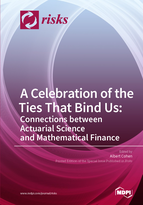A Celebration of the Ties That Bind Us: Connections between Actuarial Science and Mathematical Finance
A special issue of Risks (ISSN 2227-9091).
Deadline for manuscript submissions: closed (30 April 2017) | Viewed by 51175
Special Issue Editor
Interests: financial mathematics; financial markets; actuarial science; insurance; financial risk management
Special Issues, Collections and Topics in MDPI journals
Special Issue Information
Dear Colleagues,
In the nearly thirty years since Hans Buhlmann1 set out the notion of the Actuary of the Third Kind, the connection between Actuarial Science (AS) and Mathematical Finance (MF) has been continually reinforced. As siblings in the family of Risk Management techniques, practitioners in both fields have learned a great deal from each other. This current Special Issue is set out before the reader in this spirit of cooperation between folks who are, not only experts in both AS and MF, but also those who present diverse perspectives from industry, as well as academia.
Topics from multiple areas, such as Stochastic Modeling, Credit Risk, Monte Carlo Simulation, and Pension Valuation, among others, that were maybe thought to belong to the domain of one type of risk manager are shown time and again to have deep value to other areas of risk management as well.
It is my hope that this Special Issue will inspire future collaboration between those who seek an interdisciplinary approach to risk management.
References
1. Buhlmann, Hans. 1987. Actuaries of the Third Kind (editorial). ASTIN Bulletin 17(2): 137–138.
Dr. Albert Cohen
Guest Editor
Manuscript Submission Information
Manuscripts should be submitted online at www.mdpi.com by registering and logging in to this website. Once you are registered, click here to go to the submission form. Manuscripts can be submitted until the deadline. All submissions that pass pre-check are peer-reviewed. Accepted papers will be published continuously in the journal (as soon as accepted) and will be listed together on the special issue website. Research articles, review articles as well as short communications are invited. For planned papers, a title and short abstract (about 100 words) can be sent to the Editorial Office for announcement on this website.
Submitted manuscripts should not have been published previously, nor be under consideration for publication elsewhere (except conference proceedings papers). All manuscripts are thoroughly refereed through a single-blind peer-review process. A guide for authors and other relevant information for submission of manuscripts is available on the Instructions for Authors page. Risks is an international peer-reviewed open access monthly journal published by MDPI.
Please visit the Instructions for Authors page before submitting a manuscript. The Article Processing Charge (APC) for publication in this open access journal is 1800 CHF (Swiss Francs). Submitted papers should be well formatted and use good English. Authors may use MDPI's English editing service prior to publication or during author revisions.
Keywords
- risk management
- actuarial science
- simulation
- credit risk
- stochastic modeling
- model calibration
- actuary of the third kind






